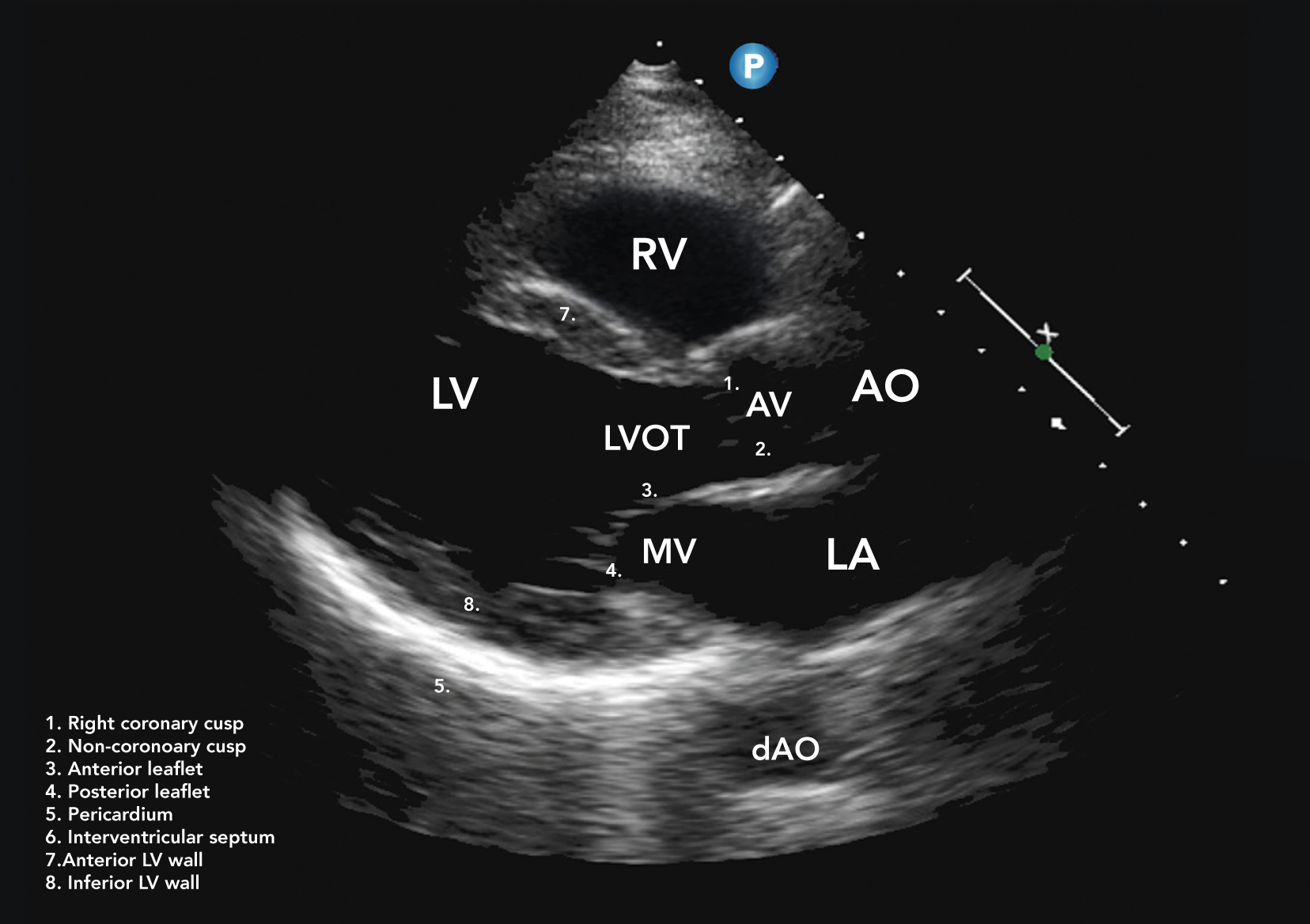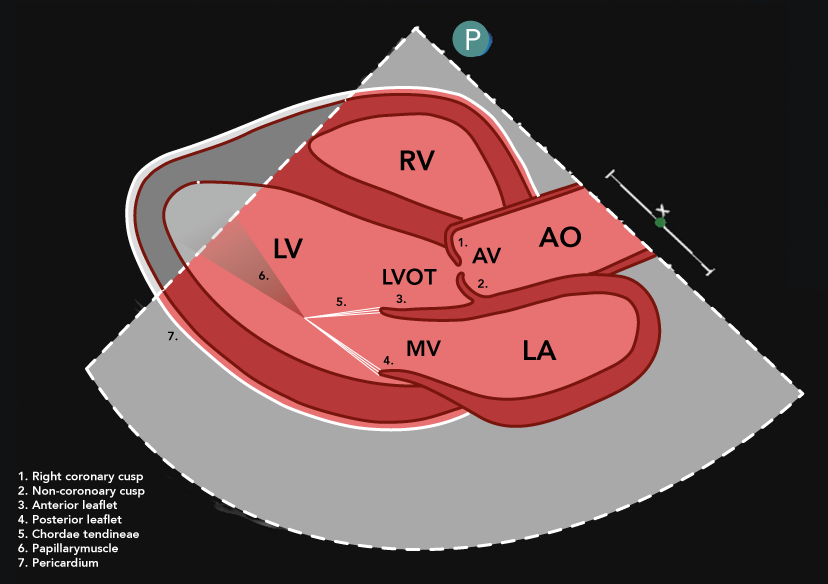Parasternal Long Axis (PLAX) Views
PLAX Increased Depth


Visual Assessment
- Pleural space
- Pericardial space
PLAX Left Ventricle


Visual Assessment
- Global LV function
- Regional wall motion
2D Measurement
- Intraventricular septum diameter (IVSd)
- Left ventricle end-diastolic diameter (LVEDd)
- Left ventricle posterior wall diameter (LVPWd)
- Left ventricle end-diastolic diameter (LVESd)
In end-diastole
In end-systole:
- Performed in end-diastole and end-systole.
- Measurements are made at the same level, perpendicular to the long-axis plane of the LV and immediately below the mitral valve leaflet tips.
- Ensure that the measurement is of compacted myocardium only and that trabeculation / valve apparatus avoided.
- When present, measure distal (more apical) to the septal bulge.
2D Measurement
- Left atrial diameter (LAd)
In end-systole
- Inner edge to inner edge method is used at end-systole.
- Measure perpendicular to the aortic root and at the level of the sinus of Valsalva.Inner edge to inner edge method is used at end-systole.
- M-mode measurement not recommended due to risk of oblique measurement.
2D Measurement
- Right ventricular outflow tract diameter (RVOTd)
In end-diastole
- Adjust depth and focal zone to visualise the RVOT.
- Inner edge to inner edge method is used at end-diastole.
- Measure using a perpendicular line from the RVOT wall to the junction between the interventricular septum and aortic valve.
M-Mode Measurement
- Fractional shortening
PLAX Mitral Valve (+/- Zoom)


Visual Assessment
- Mitral valve morphology
M-Mode Measurement
- Assessment of valve excursion
- E-point septal separation (EPSS)
M-Mode Measurement
- Mitral Regurgitant jet
- M-mode assessment of timing of regurgitant jet
- Optimise colour flow Doppler (CFD) settings.
- Adjust the lateral CFD region of interest (ROI) to include 1 cm of the LV on the left lateral border and the roof of the LA on the right lateral border. Height should not extend beyond the anterior and posterior LA walls.
PLAX Aortic Valve (+/- Zoom)


Visual Assessment
- Mitral valve morphology
M-Mode Measurement
- Assessment of valve excursion
- E-point septal separation (EPSS)
M-Mode Measurement
- Mitral Regurgitant jet
- M-mode assessment of timing of regurgitant jet
- Optimise colour flow Doppler (CFD) settings.
- Adjust the lateral CFD region of interest (ROI) to include 1 cm of the LV on the left lateral border and the roof of the LA on the right lateral border. Height should not extend beyond the anterior and posterior LA walls.
PLAX Right Ventricle Inflow


Visual Assessment
- Mitral valve morphology
M-Mode Measurement
- Assessment of valve excursion
- E-point septal separation (EPSS)
M-Mode Measurement
- Mitral Regurgitant jet
- M-mode assessment of timing of regurgitant jet
- Optimise colour flow Doppler (CFD) settings.
- Adjust the lateral CFD region of interest (ROI) to include 1 cm of the LV on the left lateral border and the roof of the LA on the right lateral border. Height should not extend beyond the anterior and posterior LA walls.
PLAX Right Ventricle Outflow


Visual Assessment
- Mitral valve morphology
M-Mode Measurement
- Assessment of valve excursion
- E-point septal separation (EPSS)
M-Mode Measurement
- Mitral Regurgitant jet
- M-mode assessment of timing of regurgitant jet
- Optimise colour flow Doppler (CFD) settings.
- Adjust the lateral CFD region of interest (ROI) to include 1 cm of the LV on the left lateral border and the roof of the LA on the right lateral border. Height should not extend beyond the anterior and posterior LA walls.
Parasternal Short Axis (PSAX) Views
PSAX Outflow


Visual Assessment
- Mitral valve morphology
M-Mode Measurement
- Assessment of valve excursion
- E-point septal separation (EPSS)
M-Mode Measurement
- Mitral Regurgitant jet
- M-mode assessment of timing of regurgitant jet
- Optimise colour flow Doppler (CFD) settings.
- Adjust the lateral CFD region of interest (ROI) to include 1 cm of the LV on the left lateral border and the roof of the LA on the right lateral border. Height should not extend beyond the anterior and posterior LA walls.
PSAX AV Zoomed


Visual Assessment
- Mitral valve morphology
M-Mode Measurement
- Assessment of valve excursion
- E-point septal separation (EPSS)
M-Mode Measurement
- Mitral Regurgitant jet
- M-mode assessment of timing of regurgitant jet
- Optimise colour flow Doppler (CFD) settings.
- Adjust the lateral CFD region of interest (ROI) to include 1 cm of the LV on the left lateral border and the roof of the LA on the right lateral border. Height should not extend beyond the anterior and posterior LA walls.
PSAX RVOT


Visual Assessment
- Mitral valve morphology
M-Mode Measurement
- Assessment of valve excursion
- E-point septal separation (EPSS)
M-Mode Measurement
- Mitral Regurgitant jet
- M-mode assessment of timing of regurgitant jet
- Optimise colour flow Doppler (CFD) settings.
- Adjust the lateral CFD region of interest (ROI) to include 1 cm of the LV on the left lateral border and the roof of the LA on the right lateral border. Height should not extend beyond the anterior and posterior LA walls.
PSAX IAS


Visual Assessment
- Mitral valve morphology
M-Mode Measurement
- Assessment of valve excursion
- E-point septal separation (EPSS)
M-Mode Measurement
- Mitral Regurgitant jet
- M-mode assessment of timing of regurgitant jet
- Optimise colour flow Doppler (CFD) settings.
- Adjust the lateral CFD region of interest (ROI) to include 1 cm of the LV on the left lateral border and the roof of the LA on the right lateral border. Height should not extend beyond the anterior and posterior LA walls.
